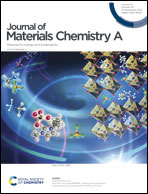Presentation of gas-phase-reactant-accessible single-rhodium-atom catalysts for CO oxidation, via MOF confinement of an Anderson polyoxometalate†
Abstract
Geometric or electronic confinement of guests within nanoporous hosts holds promise for imparting catalytic functionality, including single-metal-atom catalytic functionality, to existing materials. When the nanoporous host is a metal–organic framework (MOF), single-metal-ion catalysts have typically been installed by grafting to an open site on an inorganic node, with the node effectively becoming the support for the catalyst. This approach, however, imposes compositional constraints, as the node not only needs to be receptive to grafting, but also must be capable of stabilizing the framework against solvent evacuation, chemical exposure, and heating. Here, we show that disk-like, Anderson polyoxometalate clusters (RhMo6O24n− and Mo7O24m−; POMs) can be confined in pore-specific and orientation-specific fashion within the hierarchically porous, Zr(IV)-based MOF, NU1K. Self-limiting loading of one cluster per pore, and associated nano-confinement, serve to isolate each POM and prevent consolidation caused by sintering. Additionally, the oriented confinement serves to expose individual rhodium atoms to candidate gas-phase reactants, while enabling the rhodium atom to employ a well-defined oxy-molybdenum cluster, rather than a MOF node, as a support. Synchrotron-based difference-electron-density maps and differential pair-distribution-function analyses of scattered X-rays establish cluster siting and orientation and confirm isolation. Nanoconfined (i.e., MOF- and POM-confined) single-rhodium(III)-atoms are catalytically competent for an illustrative gas-phase reaction, CO oxidation by O2, with the MOF-isolated POM enormously outperforming nonporous, MOF-free, solid (NH4)3[H6RhMo6O24]·6H2O. This work highlights the value of MOF-based nano-confinement and oriented isolation of planar POMs as a means of uniformly presenting and stabilizing potent single-metal-atom catalysts, in reactant-accessible form, on well-defined supports.



 Please wait while we load your content...
Please wait while we load your content...
